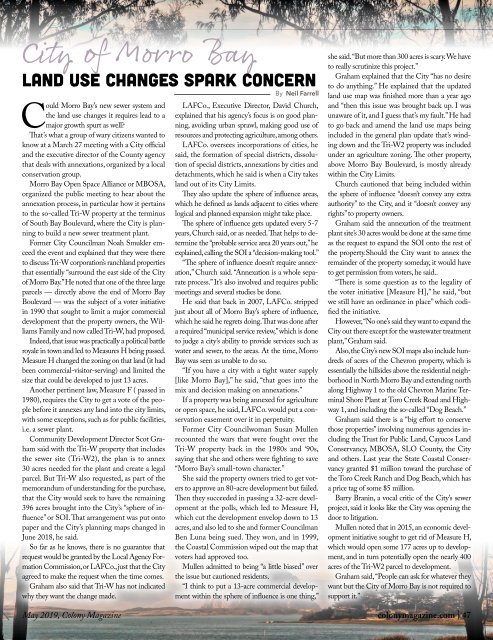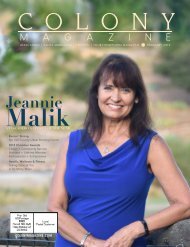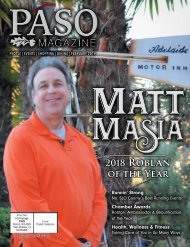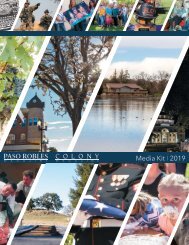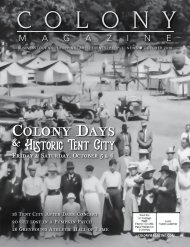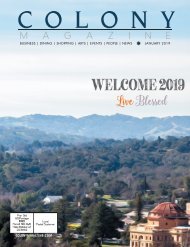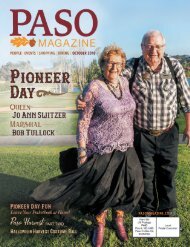2019 May Colony Magazine
The Story of Us - The Wonderful Communities of Atascadero, Morro Bay, and Santa Margarita, delivered monthly.
The Story of Us - The Wonderful Communities of Atascadero, Morro Bay, and Santa Margarita, delivered monthly.
You also want an ePaper? Increase the reach of your titles
YUMPU automatically turns print PDFs into web optimized ePapers that Google loves.
TIDES | MORRO BAY<br />
City of Morro Bay<br />
land use changes spark concern<br />
By Neil Farrell<br />
Could Morro Bay’s new sewer system and<br />
the land use changes it requires lead to a<br />
major growth spurt as well?<br />
That’s what a group of wary citizens wanted to<br />
know at a March 27 meeting with a City official<br />
and the executive director of the County agency<br />
that deals with annexations, organized by a local<br />
conservation group.<br />
Morro Bay Open Space Alliance or MBOSA,<br />
organized the public meeting to hear about the<br />
annexation process, in particular how it pertains<br />
to the so-called Tri-W property at the terminus<br />
of South Bay Boulevard, where the City is planning<br />
to build a new sewer treatment plant.<br />
Former City Councilman Noah Smukler emceed<br />
the event and explained that they were there<br />
to discuss Tri-W corporation’s ranchland properties<br />
that essentially “surround the east side of the City<br />
of Morro Bay.” He noted that one of the three large<br />
parcels — directly above the end of Morro Bay<br />
Boulevard — was the subject of a voter initiative<br />
in 1990 that sought to limit a major commercial<br />
development that the property owners, the Williams<br />
Family and now called Tri-W, had proposed.<br />
Indeed, that issue was practically a political battle<br />
royale in town and led to Measures H being passed.<br />
Measure H changed the zoning on that land (it had<br />
been commercial-visitor-serving) and limited the<br />
size that could be developed to just 13 acres.<br />
Another pertinent law, Measure F ( passed in<br />
1980), requires the City to get a vote of the people<br />
before it annexes any land into the city limits,<br />
with some exceptions, such as for public facilities,<br />
i.e. a sewer plant.<br />
Community Development Director Scot Graham<br />
said with the Tri-W property that includes<br />
the sewer site (Tri-W2), the plan is to annex<br />
30 acres needed for the plant and create a legal<br />
parcel. But Tri-W also requested, as part of the<br />
memorandum of understanding for the purchase,<br />
that the City would seek to have the remaining<br />
396 acres brought into the City’s “sphere of influence”<br />
or SOI. That arrangement was put onto<br />
paper and the City’s planning maps changed in<br />
June 2018, he said.<br />
So far as he knows, there is no guarantee that<br />
request would be granted by the Local Agency Formation<br />
Commission, or LAFCo., just that the City<br />
agreed to make the request when the time comes.<br />
Graham also said that Tri-W has not indicated<br />
why they want the change made.<br />
LAFCo., Executive Director, David Church,<br />
explained that his agency’s focus is on good planning,<br />
avoiding urban sprawl, making good use of<br />
resources and protecting agriculture, among others.<br />
LAFCo. oversees incorporations of cities, he<br />
said, the formation of special districts, dissolution<br />
of special districts, annexations by cities and<br />
detachments, which he said is when a City takes<br />
land out of its City Limits.<br />
They also update the sphere of influence areas,<br />
which he defined as lands adjacent to cities where<br />
logical and planned expansion might take place.<br />
The sphere of influence gets updated every 5-7<br />
years, Church said, or as needed. That helps to determine<br />
the “probable service area 20 years out,” he<br />
explained, calling the SOI a “decision-making tool.”<br />
“The sphere of influence doesn’t require annexation,”<br />
Church said. “Annexation is a whole separate<br />
process.” It’s also involved and requires public<br />
meetings and several studies be done.<br />
He said that back in 2007, LAFCo. stripped<br />
just about all of Morro Bay’s sphere of influence,<br />
which he said he regrets doing. That was done after<br />
a required “municipal service review,” which is done<br />
to judge a city’s ability to provide services such as<br />
water and sewer, to the areas. At the time, Morro<br />
Bay was seen as unable to do so.<br />
“If you have a city with a tight water supply<br />
[like Morro Bay],” he said, “that goes into the<br />
mix and decision making on annexations.”<br />
If a property was being annexed for agriculture<br />
or open space, he said, LAFCo. would put a conservation<br />
easement over it in perpetuity.<br />
Former City Councilwoman Susan Mullen<br />
recounted the wars that were fought over the<br />
Tri-W property back in the 1980s and ‘90s,<br />
saying that she and others were fighting to save<br />
“Morro Bay’s small-town character.”<br />
She said the property owners tried to get voters<br />
to approve an 80-acre development but failed.<br />
Then they succeeded in passing a 32-acre development<br />
at the polls, which led to Measure H,<br />
which cut the development envelop down to 13<br />
acres, and also led to she and former Councilman<br />
Ben Luna being sued. They won, and in 1999,<br />
the Coastal Commission wiped out the map that<br />
voters had approved too.<br />
Mullen admitted to being “a little biased” over<br />
the issue but cautioned residents.<br />
“I think to put a 13-acre commercial development<br />
within the sphere of influence is one thing,”<br />
she said. “But more than 300 acres is scary. We have<br />
to really scrutinize this project.”<br />
Graham explained that the City “has no desire<br />
to do anything.” He explained that the updated<br />
land use map was finished more than a year ago<br />
and “then this issue was brought back up. I was<br />
unaware of it, and I guess that’s my fault.” He had<br />
to go back and amend the land use maps being<br />
included in the general plan update that’s winding<br />
down and the Tri-W2 property was included<br />
under an agriculture zoning. The other property,<br />
above Morro Bay Boulevard, is mostly already<br />
within the City Limits.<br />
Church cautioned that being included within<br />
the sphere of influence “doesn’t convey any extra<br />
authority” to the City, and it “doesn’t convey any<br />
rights” to property owners.<br />
Graham said the annexation of the treatment<br />
plant site’s 30 acres would be done at the same time<br />
as the request to expand the SOI onto the rest of<br />
the property.Should the City want to annex the<br />
remainder of the property someday, it would have<br />
to get permission from voters, he said..<br />
“There is some question as to the legality of<br />
the voter initiative [Measure H],” he said, “but<br />
we still have an ordinance in place” which codified<br />
the initiative.<br />
However, “No one’s said they want to expand the<br />
City out there except for the wastewater treatment<br />
plant,” Graham said.<br />
Also, the City’s new SOI maps also include hundreds<br />
of acres of the Chevron property, which is<br />
essentially the hillsides above the residential neighborhood<br />
in North Morro Bay and extending north<br />
along Highway 1 to the old Chevron Marine Terminal<br />
Shore Plant at Toro Creek Road and Highway<br />
1, and including the so-called “Dog Beach.”<br />
Graham said there is a “big effort to conserve<br />
those properties” involving numerous agencies including<br />
the Trust for Public Land, Cayucos Land<br />
Conservancy, MBOSA, SLO County, the City<br />
and others. Last year the State Coastal Conservancy<br />
granted $1 million toward the purchase of<br />
the Toro Creek Ranch and Dog Beach, which has<br />
a price tag of some $5 million.<br />
Barry Branin, a vocal critic of the City’s sewer<br />
project, said it looks like the City was opening the<br />
door to litigation.<br />
Mullen noted that in 2015, an economic development<br />
initiative sought to get rid of Measure H,<br />
which would open some 177 acres up to development,<br />
and in turn potentially open the nearly 400<br />
acres of the Tri-W2 parcel to development.<br />
Graham said, “People can ask for whatever they<br />
want but the City of Morro Bay is not required to<br />
support it.”<br />
<strong>May</strong> <strong>2019</strong>, <strong>Colony</strong> <strong>Magazine</strong> colonymagazine.com | 47


